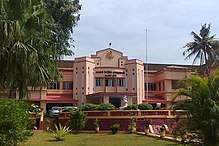Nair Service Society
The Nair Service Society (NSS) is an organisation created for the social advancement and welfare of the Nair community that is found primarily in the state of Kerala in South India. It was established under the leadership of Mannathu Padmanabha Pillai.[1] The NSS is a three-tier organisation with Karayogams at the base level, Taluk Unions at the intermediate level and a central headquarters operating from Perunna, Changanassery in Kerala. G. Sukumaran Nair is the present General Secretary.
NSS Headquarters Main Gate, Perunna | |
| Abbreviation | NSS |
|---|---|
| Formation | 31 October 1914 |
| Founder | Mannathu Padmanabha Pillai |
| Type | Caste-based organization |
| Headquarters | Perunna, Changanassery |
| Location | |
Official language | Malayalam |
General Secretary | G. Sukumaran Nair |
| Website | nss.org.in |
Formerly called | Nair Brithya Jana Sangham |

The Society owns and manages many educational institutions and hospitals.
Origins
The Nair Service Society was formed on 31 October 1914[2] as a reaction to perceived communal slights in the princely state of Travancore in southern India, which now forms a part of the state of Kerala.[3] At the time of formation, K. Kelappan was the president and Mannathu Padmanabhan was the secretary. Nairs were the most economically and socially dominant community, as well as the most numerous, in what was traditionally a staunchly Hindu kingdom that rigorously and officially enforced distinctions between castes.[4] Some Nairs had felt provoked by the rise to prominence of the Saint Thomas Christians during the era of British rule and whose members were being elected as chairs of various official bodies during a period when the political systems were being modified.[3]
The Nairs believed Travancore to be a Hindu state[3] and the founders of the NSS believed that their own community could only counter the changing socio-political situation if it presented a united front and did away with its internal social subdivisions.[5][lower-alpha 1] The first caste association of this type to have been formed in the region was the Sree Narayana Dharma Paripalana Yogam (SNDP), established in 1903 to work for the benefit of the Ezhava community.[6]
Branches
Expatriate Nairs both in other states of India as well as in foreign countries have formed Nair Service Societies in their states and countries of domicile. Examples are Karnataka Nair Service Society with 30 Karayogams[7] and the Kanyakumari Nair Service Society with 27 Karayogams, NSS Vidarbha, which unites Nairs living in the Vidarbha region of Maharashtra. NSS is also having branches in Nagpur, Chandrapur[8] and NSS of North America (NSSONA) with many Karayogams in North America.[9]
In 2010 October, Nair organisations from around the world decided to form a united body. As a result, the Global Nair Service Society was founded after a meeting attended by thousands in New Delhi.[10]
Strength
As of 2010 the NSS comprised:[11]
- Taluk Unions : 58
- Karayogams (village communities) : 5300
- Vanitha Samajams : 4232
- Bala Samajams : 2466
NSS has also started many schools under its supervision. Collectively named NSS HSS or NSS High Schools, these schools function in almost all parts of the state of Kerala.[11]
Officers
Past presidents include K. Kelappan who was the first president of NSS and K. P. Karunakara Menon.
References
Notes
- The success of the NSS with regard to abolishing the subdivisions is moot: British Raj census reports of 1931 and 1941 varied in their interpretation of the available data and Christopher Fuller, an anthropologist, noted in 1975 that intermarriage between the various groups was "very rare". Fuller notes that "... many Nayars see the persistence of subdivisions within their community as a social and political problem, and they tend to deny their existence when outsidersask about them.[5]
Citations
- "NSS concerns on education will be addressed: Chandy". The Hindu Daily. 3 January 2016.
- "Founder". Nair Service Society. Retrieved 7 May 2013.
- Devika, J.; Varghese, V. J. (March 2010). To Survive or to flourish? Minority rights and Syrian Christian assertions in 20th century Travancore (PDF). Trivandrum: Centre for Development Studies. pp. 15–17. Archived from the original (PDF) on 26 May 2012. Retrieved 15 May 2017.
- Jeffrey, Robin (1974). "The social origins of a caste association, 1875-1905: The founding of the S.N.D.P. Yogam". South Asia: Journal of South Asian Studies. 1. 4 (1): 39–59. doi:10.1080/00856407408730687. (subscription required)
- Fuller, Christopher J. (Winter 1975). "The Internal Structure of the Nayar Caste". Journal of Anthropological Research. University of New Mexico. 31 (4): 283–312. JSTOR 3629883. (subscription required)
- Nossiter, Thomas Johnson (1982). Communism in Kerala: a study in political adaptation. University of California Press. p. 30. ISBN 978-0-520-04667-2. Retrieved 7 May 2013.
- "Amma Show Bengaluru". Archived from the original on 8 February 2011. Retrieved 15 May 2017.
- "Welcome to Vidarbha Nair Tharavadu: Setting up Organizational Network". Retrieved 15 May 2017.
- "Nair Service Society of North America". Retrieved 15 May 2017.
- "Global Nair organisation to be launched in Delhi Sunday". IndiaVision News. New Delhi. 18 October 2010. Retrieved 19 January 2011.
- nss.org.in - The Official Website of Nair Service Society